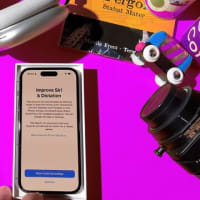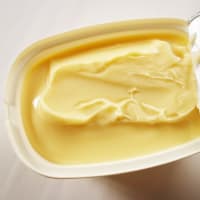Me Hey, Dali, do you like Japanese curry?
私 ねえダリちゃん、ダリちゃんは日本のカレーは好き?
Dali Yes, I love all curries. Indian curry, Thai curry, and of course Japanese curry. I ate Japanese curry for the first time after I came to Japan.
ダリちゃん うん。全てのカレーが好き。インドカレー、タイカレー、そしてもちろん日本のカレー。わしは日本に来て初めて日本のカレーを食べたんだ。
Me Oh, really?
私 へー、本当?
Dali But the first encounter with it was, actually, in the US,
where I, fresh from college, was working as a waiter at a Japanese restaurant, the
owner of which was a native Japanese. One day, a middle-aged Japanese man came
to our restaurant. The owner talked happily with the man. I was a little bit nervous
because the customer couldn’t speak English. How could I take his order? Seeing
me bewildered, the owner said to me, “Don’t worry about this customer. I’ll
take care of him.” The owner then prepared for him a dish which was not on the
menu. He packed rice into a mold, inverted it onto the plate, and poured a
yellow, viscous sauce over the rice. At the time, I didn’t know what it was.
But I remember the spicy, delicious smell, which whetted my appetite.
Unfortunately, I had no opportunity to taste it, while I was in the US. This
restaurant did not allow Americans to try it. By the way, do you know the
origin of Japanese curry?
ダリちゃん でもね、初めて日本のカレーに出会ったのは実はアメリカにいた時なんだ。大学を卒業したての頃、日本食レストランでウェイターをしていた時かな。オーナーは生粋の日本人でね。ある日、中年の日本人がそのレストランに来たんだ。オーナーは楽しそうにその男と喋っていた。そのお客は英語が喋れなかったのでわしは少しおろおろした。どうやってオーダーを取ろうかとね。わしがうろたえているのを見てオーナーはわしに「この客のことは心配しなくていい。私が相手するから」と言った。それからオーナーはその客にメニューに載っていない料理を作った。オーナーはご飯を型に詰め、お皿の上に逆さにして型から抜き、その上に黄色いドロッとしたソースを注いだ。わしはそれがなんだかわからなかった。でも食欲をそそるスパイシーでおいしそうな匂いは覚えている。残念ながら、アメリカにいる間にそれを食べる機会に恵まれなかった。そのレストランではアメリカ人がそれを食べることは許されなかった。ところで、日本のカレーのルーツ、知ってる?
Me No.
私 いや。
Dali Well, I will tell you. Indian curry was first introduced to Japan via England. It was the early Meiji period. At that time, curry in Japan was made from curry powder, imported from Crosse & Blackwell (C & B) of England. Being imported, it was very expensive. But, in 1903, a wholesale drug company in Osaka, named Hachi curry, succeeded in producing the first domestic Japanese curry powder, which greatly popularized curry for general public. The president of the company had a hint from the C & B curry powder, which smelled like Kampo, and so decided to use Ukon (turmeric) to produce his curry powder.
ダリちゃん じゃあ、教えてあげよう。インドカレーがイギリスを介して初めて日本に紹介された。明治初期だった。当時、日本のカレーはイギリスのクロス&ブラックウェル(C&B)という会社から輸入されたカレー粉から作られていた。輸入品なのでとても高価だった。でも1903年に「ハチカレー」という大阪の薬の卸会社が初めて国産のカレー粉を作るのに成功したことで、カレーは一般大衆に広まった。ハチカレーの社長はC&Bのカレー粉が漢方の匂いがすることにヒントを受け、カレー粉を作るのにウコンを使うことにした。
Me Oh, you know very much about the history of Japanese curry!
私 へー、ダリちゃんは日本のカレーの歴史についてよく知ってるね!
Dali Yes. And it was in the Taisho era, when the well-known food maker, the House Company, was founded in Osaka. At that time, it sold mainly Kampo ingredients, such as Daiou (Rhubarb), Choji (clove), Nikki (cinnamon), Senburi, cumin, and sage.
ダリちゃん そう。そして大正時代に入ると有名な食品メーカーのハウスが大阪に設立されたんだ。当時ハウスは、ダイオウ、丁子、ニッキ、センブリ、クミン、セージなど、主に漢方の素材を売っていたんだ。

Chinese medicine with medical herbs
Me It seems that curry powder of that time was related to Kampo. Do you often eat curry and rice?
私 当時のカレー粉は漢方に関係していたみたいだね。ダリちゃんはよくカレーライスを食べるの?
Dali Yes!
But I wonder why it is generally served unmixed on the plate―one half of the plate white rise,
and the other half curry. We are expected to take a bit of rice, and a bit of
curry in each spoonful. As we eat, we try to take equal amounts of each.
However, it’s not easy to end up with equal amounts. If you eat more rice than curry,
curry remains. Alternatively, if you eat more curry, rice remains. To avoid such
inconvenience, before eating, I always thoroughly mix the curry and the rice
with a spoon. Then, I eat the resultant mixture with chopsticks.
ダリちゃん うん。でも、なぜカレーライスは普通、お皿の上に混ぜない状態で出されるんだろう。つまり、お皿の半分は白ご飯で、もう半分はカレー。スプーンにご飯を少しとカレーを少し取って食べろという事だろうけど、食べるときにはご飯とカレーを等量取るようにしている。でも結局、同じ量を取るのは容易じゃないんだね。カレーよりご飯を多く食べるとカレーが残る。逆に、カレーを多く食べるとご飯が残る。そのような不便を避ける為、わしは食べる前にいつもスプーンでカレーとご飯をぐちゃぐちゃに混ぜるんだ。それから、出来上がった混合物をお箸で食べるんだ。
Me That doesn’t sound very appetizing.
私 あんまり食欲わかないな。
Dali Yes! Anyway, my wife, Reiko, sometimes makes
me Japanese curry. When I mix the curry and the rice together before eating,
she used to have a puzzled look on her face, but now she is indifferent to my
way of eating.
ダリちゃん そんなことないよ! それはそうとわしの妻の冷子は時々わしに日本のカレーを作ってくれる。わしが食べる前にカレーとご飯をぐちゃぐちゃに混ぜるのを見て、彼女はよく困惑した表情をしていたけど、今じゃわしの食べ方に何も反応しなくなった。
Key
words(キーワード)
bewildered:
当惑させる、うろたえさせる、まごつかせる
viscous:
粘る、粘り気のある
whet:
(砥石で)とぐ、刺激する、強める
wholesale:
卸、卸売り
alternatively:
二者択一的に、代わりに、あるいは
inconvenience:
不便、不自由、迷惑、不便なこと
puzzled
look: 不審顔
indifferent:
無関心で、冷淡で、無頓着で
Comments(コメント)
Now, there is a huge variety of Japanese curry available in Japan. Spicy curry might contain lots of kinds of spices, such as turmeric, paprika, coriander, cumin, red chili, cinnamon, cardamom, black pepper, garam masala…
今では、日本では本当に色々な種類のカレーが食べられる。スパイスの効いたカレーはたくさんの種類のスパイスが使われている。ターメリック、パプリカ、コリアンダー、クミン、レッドチリ、シナモン、カルダモン、黒胡椒、ガラムマサなどなど……





















